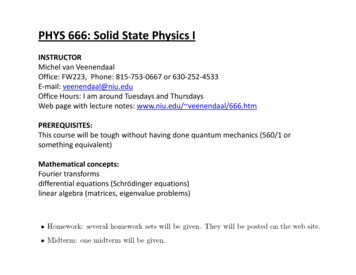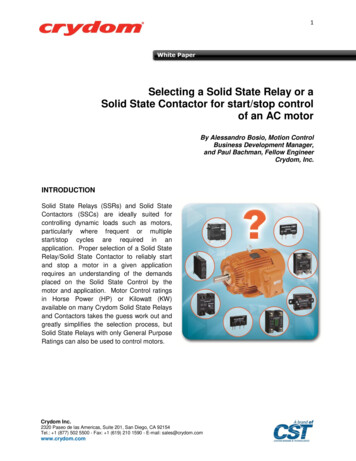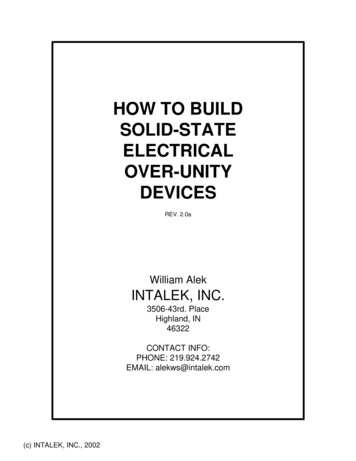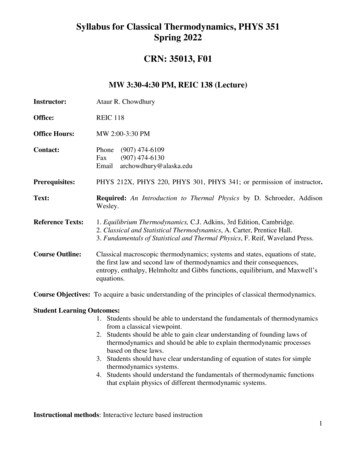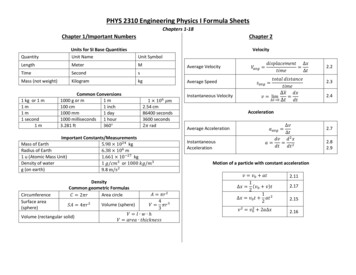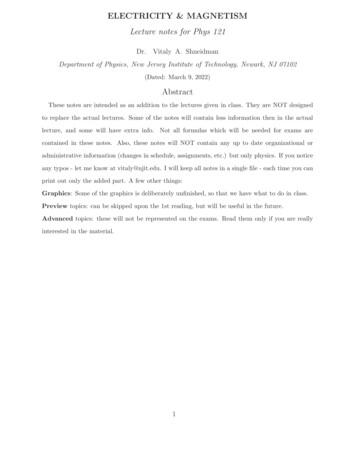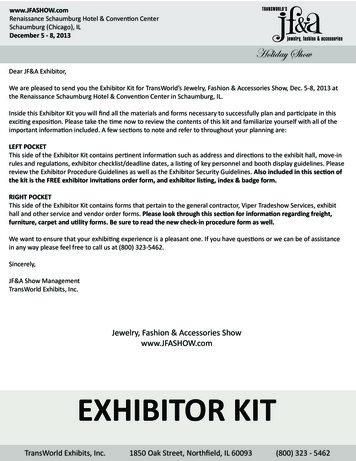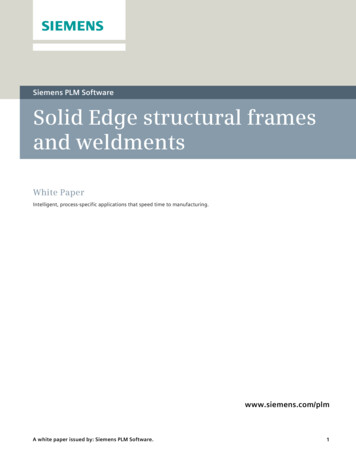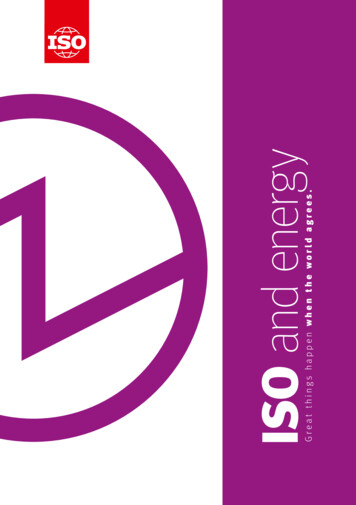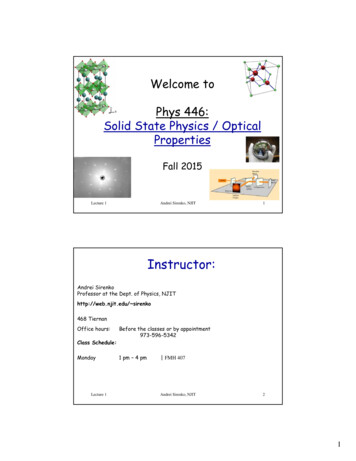
Transcription
Welcome toPhys 446:Solid State Physics / OpticalPropertiesFall 2015Lecture 1Andrei Sirenko, NJIT1Instructor:Andrei SirenkoProfessor at the Dept. of Physics, NJIThttp://web.njit.edu/ sirenko468 TiernanOffice hours:Before the classes or by appointment973-596-5342Class Schedule:MondayLecture 11 pm – 4 pm FMH 407Andrei Sirenko, NJIT21
Plan for today: Introduction to the Course CrystalsLecture 1Andrei Sirenko, NJIT3Course Elements:Textbooks:M. A. Omar, “Elementary Solid State Physics”, Addison-Wesley, 1993.Charles Kittel, Introduction to Solid State Physics, 8th Edition, Wiley, 2004.Supplemental texts: H. Ibach, H. Lüth, “Solid-State Physics. An Introduction to Principles of MaterialsScience”, Springer, 2003. J. S. Blakemore, "Solid State Physics”, Third Edition, Cambridge University Press,1985 P. Yu and M. Cardona, “Fundamentals of semiconductors” N. W. Ashcroft and N. D. Mermin, “Solid State Physics”Lecture SlidesDemonstrations in the Experimental Lab at NJIT– Raman Scattering in Diamond– High-Resolution X-ray Diffraction in Silicon wafer– Transmission in InP-based multilayer device structure– Micro-beam Photoluminescence in InGaAsP-based waveguide device structureGrade Components:– Homework: 10 %– Research project: 10 %– Two in-class exams: 15% each;– Final exam: 50%Lecture 1Andrei Sirenko, NJIT42
Course Goals:This course integrates theory of Solid State Physics with experimentaldemonstrations in the Research Physics Lab. The course will provide avaluable theoretical introduction and an overview of the fundamentalapplications of the physics of solids. This course includes theoretical descriptionof crystal and electronic structure, lattice dynamics, and optical properties ofdifferent materials (metals, semiconductors, dielectrics, magnetic materials andsuperconductors), based on the classical and quantum physics principles.Several advanced experiments of X-ray diffraction, Raman Scattering,Photoluminescence, etc., will be carrier out in the Research Physics Labfollowed by their theoretical discussion.To help you with your research projects and future jobsLecture 1Andrei Sirenko, NJIT5Lecture 1Andrei Sirenko, NJIT63
Lecture 1Andrei Sirenko, NJIT7Outline of the course: I.Crystal structure, symmetry and types of chemical bonds. (Chapter 1)The crystal latticePoint symmetryThe 32 crystal classesTypes of bonding (covalent, ionic, metallic bonding; hydrogen and van der Waals). II. Diffraction from periodic structures (Chapter 2)Reciprocal lattice; Brillouin zonesLaue condition and Bragg lawStructure factor; defectsMethods of structure analysisHRXRD. Experimental demonstration in the Physics Lab using Bruker D8 Discover XRD III. Lattice vibrations and thermal properties (Chapter 3)Elastic properties of crystals; elastic wavesModels of lattice vibrationsPhononsTheories of phonon specific heat; thermal conduction.Anharmonicity; thermal expansionRaman Scattering by phonons. Experimental demonstration in the Physics Lab using Ar-laser/SPEX 500M, CCD –based Raman Scattering setup IV.Electrons in metals (Chapters 4–5)Free electron theory of metalsFermi StatisticsBand theory of solids V. Semiconductors (Chapters 6–7)Band structure.Electron statistics; carrier concentration and transport; conductivity; mobilityImpurities and defectsMagnetic field effects: cyclotron resonance and Hall effectOptical properties; absorption, photoconductivity and luminescenceBasic semiconductor devicesPhotoluminescence. Experimental demonstration in the Physics Lab using Nd:YAG laser/SPEX –based Photoluminescence setup VI.Dielectric properties of solids (Chapters 8)Dielectric constant and polarizability (susceptibility)Dipolar polarizability, ionic and electronic polarizabilityPiezoelectricity; pyro- and ferroelectricityLight propagation in solids VII. Magnetism (Chapters 9)Magnetic susceptibilityClassification of materials; diamagnetism, paramagnetismFerromagnetism and antiferromagnetismMagnetic resonanceMultiferroic Materials VIII. Superconductivity (Chapter 10)Lecture 1Andrei Sirenko, NJIT84
Lectures: Lecture 1Presentation of the concepts and techniques of SSP.Demonstrations.HW discussionsLectures are not a substitute for reading the textbookand independent literature searchRead ahead; you’ll get more from lecture.Slides are posted on the course web. Slides will beupdated during the SemesterUse these as a study guide/note taking aidAndrei Sirenko, NJIT9Scope and RequirementsRequired for Phys-446PHYS-III and PHYS 432 and 433 (E&M-I and II )Familiarity with basic principles of quantum mechanics(Schrödinger equation, wave function, energy levels, spin)Knowledge of basics of statistical physics (classical statistics,Bose-Einstein and Fermi-Dirac statistics)Lecture 1Andrei Sirenko, NJIT105
Homework Assignments ( 6 in total) will be due weekly, usually on Mondays.Assignments are due at the beginning of class. Homework problems, lectures, and text readings will form thebasis of the exam problems.ProjectStudents will perform a research project on a selected topic ofcontemporary solid state physics (of their choice) by reviewingscientific journal articles focusing on the effect chosen. A formaloral presentation ( 10 slides) will be required.Lecture 1Andrei Sirenko, NJIT11Exams:There will be two in-class exams and a final exam. Allowed to use lecture notes and formula sheets (but nobooks, no internet, no phone calls). Not allowed to discuss the problems with other students.Academic honestyStudents are encouraged to: discuss the lectures and textbook material work together on homework problems study together for examsBut not allowed to: present other people’s work as your own (including copyinganother student's homework as well as using of problemsolutions found in the Internet or elsewhere) discuss problems or questions during examsLecture 1Andrei Sirenko, NJIT126
Today: crystal structuresLecture 1-1“ What do you know about crystals ?“They make nice chandeliers !?.”Superman ReturnsLecture 1Andrei Sirenko, NJIT13Lecture 1Andrei Sirenko, NJIT147
Lecture 1Andrei Sirenko, NJIT15Examples: BaMnO3 and LuMnO3 crystalsOMnLuLecture 1Andrei Sirenko, NJIT168
Today: crystal structures (Omar Ch. 1.1.-1.6.)Crystal: atoms are arranged so that their positions are periodic in allthree dimensionsAtoms are bound to one another well defined equilibrium separations;many identical atoms minimum energy requires everyidentical atom to be inidentical environment 3D periodicityrn n1 a1 n2 a2 n3 a3Ideal crystal: perfect periodicityReal crystals are never perfect: surface impurities and defects thermal motion of atoms (lattice vibrations)Lecture 1Andrei Sirenko, NJIT17Lecture 1Andrei Sirenko, NJIT189
Lecture 1Andrei Sirenko, NJIT19DefinitionsThe periodic array of points is called crystal lattice.For every lattice point there is a group of atoms (orsingle atom) called basis of the latticea3Don't confuse with a1, a2, a3 - basis vectorsparallelogram formed by the basis vectors –unit cella2a1if a unit cell contains only one lattice point, it iscalled a primitive cell (minimum volume)Bravais lattices – all lattice pointsare equivalent2D case – 5 Bravais lattices in the next slideLecture 1Andrei Sirenko, NJIT2010
Lecture 1Andrei Sirenko, NJIT217 crystal systems and 14 Bravais lattices in 3Dtriclinica b ctetragonala b c, 90 PILecture 1orthorhombicmonoclinica b cPCa b c, 90 PCIFrhombohedral(trigonal)a b c, 90 cubichexagonala b c, 90 PAndrei Sirenko, NJITIFa b c, 90 120 2211
simple cubicLecture 1bccBody-centeredcubicfccFace-centered cubicAndrei Sirenko, NJIT23Andrei Sirenko, NJIT24simple cubicLecture 112
Lecture 1Andrei Sirenko, NJIT25a1 and a2 vectors?Lecture 1Andrei Sirenko, NJIT2613
Lecture 1Andrei Sirenko, NJIT27Lecture 1Andrei Sirenko, NJIT2814
Lecture 1Andrei Sirenko, NJIT29Closed-packed structures(or, what does stacking fruit have to do with solid state physics?)Lecture 1Andrei Sirenko, NJIT3015
Closed-packed structures There are an infinite number of ways toorganize spheres to maximize the packingfraction.The centersof spheresat A, B, andC positions(from Kittel)There are different ways you can pack spheres together. This shows two ways,one by putting the spheres in an ABAB arrangement, the other with ACAC .(or any combination of the two works)Lecture 1Andrei Sirenko, NJIT31(3) The Hexagonal Closed-packed (HCP)structureBe, Sc, Te, Co, Zn, Y, Zr, Tc, Ru, Gd,Tb, Py, Ho, Er, Tm, Lu, Hf, Re, Os, Tl The HCP structure is made up of stacking spheres in a ABABAB configurationThe HCP structure has the primitive cell of the hexagonal lattice, with a basis oftwo identical atomsAtom positions: 000, 2/3 1/3 ½ (remember, the unit axes are not allperpendicular)The number of nearest-neighbours is 12 The ideal ratio of c/a forthis packing is (8/3)1/2 1.633Rotatedthree times.Lecture 1Andrei Sirenko, NJIT32Conventional HCP unit cell16
HCP structureand Golden Ratio The ideal ratio of c/a forthis packing is (8/3)1/2 1.633Conventional HCP unit cellLecture 1Andrei Sirenko, NJIT33The FCC and hexagonal closed-packed structures (HCP) areformed from packing in different ways. FCC (sometimes calledthe cubic closed-packed structure, or CCP) has the stackingarrangement of ABCABCABC HCP has the arrangementABABAB .[1 1 1][0 0 1]HCPABABsequenceLecture 1FCC(CCP)(lookingalong [111]directionABCABCsequenceAndrei Sirenko, NJIT3417
HCP and FCC structures The hexagonal-closed packed(HCP) and FCC structures bothhave the ideal packing fraction of0.74 (Kepler figured this outhundreds of years ago) The ideal ratio of c/a for thispacking is (8/3)1/2 1.633 (seeProblem 3 in Kittel) Why aren’t these values perfectfor real materials? Why would real materials pickHCP or FCC (what does it matterif they pack the 1Cd1.886Co1.622Y1.570Zr1.594Gd1.592Lu1.586Lecture 1Andrei Sirenko, NJIT35Lecture 1Andrei Sirenko, NJIT3618
Lecture 1Andrei Sirenko, NJIT37Examplesrock saltperovskite (e.g. BaTiO3)diamond (Si, Ge)zincblende (GaAs .)What are the Bravais lattices for these structures?How many atoms are in the basis, and what are their positions?fccLecture 1cubicAndrei Sirenko, NJITfcc3819
Elements of symmetryIn addition to periodicity (translation) each lattice can have othersymmetry properties: Inversion center I Reflection (mirror) plane Rotation axes. Only 2-, 3-, 4-, and 6-fold rotations are compatiblewith translation invariance Rotation-inversion axesPoint symmetryEvery crystal lattice may be described by a particularcombination of symmetry operations determined by symmetry ofthe basis and the symmetry of the Bravais lattice.There are 32 crystal classes (point groups)Combining with translational symmetries, one obtains 230space groupsLecture 1Andrei Sirenko, NJIT39Elements of symmetry Inversion center I Reflection (mirror) plane Rotation axes. Only 2-, 3-, 4-, and 6-fold rotations are compatiblewith translation invariance Rotation-inversion axesLecture 1Andrei Sirenko, NJIT4020
Symmetry group example: C3v Inversion center I Reflection planes: 3 Rotation axes. Only 3- fold rotationLecture 1Andrei Sirenko, NJIT41Symmetry group example: O (cube) Inversion center I Reflection planes Rotation axesLecture 1total: 24 elements (48 with i: Oh )Andrei Sirenko, NJIT4221
Symmetry group example: O (cube) Inversion center I Reflection planes Rotation axesLecture 1total: 12 elementsAndrei Sirenko, NJIT43Notation for crystallographic directions and planes:Miller indices (see demonstration)Crystal directions:rn n1 a1 n2 a2 n3 a3If there are several equivalent directions:[n1 n2 n3] n1 n2 n3 Crystal planes:If a plane intercepts the axes at x, y, z and basis vectors are a, b, c,then one can obtain three numbers a b c , , x y z and reduce to the set of smallest integers (hkl) – Miller indices -represent a set of parallel planesIf there are several equivalent nonparallel sets of planes: {hkl}Lecture 1Andrei Sirenko, NJIT4422
Indexing system for crystalplanes Since crystal structures areobtained from diffractionexperiments (in whichparticles diffract fromplanes of atoms), it is usefulto develop a system forindexing lattice planes. We can use the latticeconstants a1, a2, a3, but itturns out to be more usefulto use what are called MillerIndices.IndexLecture 1Andrei Sirenko, NJIT45Rules for determining Miller Indices (1) Find the intercepts onthe axes in terms of thelattice constants a1, a2, a3. (2) Take the reciprocalsof these numbers and thenreduce to three integershaving the same ratio,usually the smallest of thethree integers. The result,listed as (hkl), is called theindex of the plane.Lecture 1An example:Intercepts: a, , Reciprocals: a/a, a/ , a/ 1, 0, 0Miller index for this plane : (1 0 0)(note: this is the normal vector for this plane)Andrei Sirenko, NJIT4623
Examples of Miller IndicesIntercepts: a, a, Reciprocals: a/a, a/a, a/ 1, 1, 0Miller index for this plane : (1 1 0)Lecture 1Intercepts: a,a,aReciprocals: a/a, a/a, a/a 1, 1, 1Miller index for this plane : (1 1 1)Andrei Sirenko, NJIT47Examples of Miller IndicesIntercepts: 1/2a, a, Reciprocals: 2a/a, a/a, a/ 2, 1, 0Miller index for this plane : (2 1 0)Lecture 1Andrei Sirenko, NJIT4824
Notes on notation (hkl) might mean a single plane, ora set of planesIf a plane cuts a negative axis, wehave minus signs in the (hkl) (ie.(hkl))Planes are denoted with curlybrackets (hkl)A set of faces are denoted {hkl}The direction of a crystal (forexample, along x for a cubic crystal)is denoted with [uvw] (ie. The [100]direction)In cubic crystals, the direction [hkl]is perpendicular to the plane (hkl)having the same indices, but thisisn’t necessarily true for othercrystal systems{001} face[100]direction[001] directionLecture 1Andrei Sirenko, NJIT49Summary A crystal lattice is a periodic array of the points related bytranslation operation:rn n1 a1 n2 a2 n3 a3 To form a crystal, we attach to every lattice point anidentical group of atoms called basis 7 crystal systems and 14 Bravais lattices32 crystal classes (point symmetry groups)Crystallographic directions and Miller indices; dhklContinue with interatomic forces and types of bonds in solidsLecture 1Andrei Sirenko, NJIT5025
Reciprocal latticeConstricting the reciprocal lattice from the direct lattice:Let a1, a2, a3 - primitive vectors of the direct lattice; T n1a1 n2a2 n3a3Then reciprocal lattice can be generated using the primitive vectorswhere V a1·(a2 a3) is the volume of the unit cellWe have bi·aj δijLecture 1Andrei Sirenko, NJIT51Some examples of reciprocal lattices1. Reciprocal lattice to simple cubic latticea1 ax,a2 ay,b1 (2 /a)x,a3 azb2 (2 /a)y,V a1·(a2 a3) a3b3 (2 /a)z reciprocal lattice is also cubic with lattice constant 2 /a2. Reciprocal lattice to bcc latticea1 1a x y z 2a2 1a x y z 211a x y z V a1 a 2 a 3 a 3222 2 y z b 2 x z b 3 2 x y b1 aaaa3 Lecture 1Andrei Sirenko, NJIT5226
gotb1 2 y z ab2 2 x z ab3 2 x y abut these are primitivevectors of fcc latticeSo, the reciprocal lattice to bcc is fcc.Analogously, show that the reciprocal lattice to fcc is bccLecture 1Andrei Sirenko, NJIT53Brillouin zonesDetermine all the perpendicularbisecting planes in the reciprocallatticeFirst Brillouin zone - the WignerSeitz cell of the reciprocal latticeSecond Brillouin zone:Lecture 1Higher Brillouin zones:Andrei Sirenko, NJIT5427
Brillouin zones of cubic latticesFirst BZ of a BCC latticeLecture 1First BZ of an FCC latticeAndrei Sirenko, NJIT55Summary Reciprocal lattice is defined by primitive vectors: A reciprocal lattice vector has the form G hb1 kb2 lb3It is normal to (hkl) planes of direct lattice First Brillouin zone is the Wigner-Seitz primitive cell of thereciprocal lattice Simple cubic cube; bcc Rhombic dodecahedron;fcc truncated octahedron (figures on the previous slide)Lecture 1Andrei Sirenko, NJIT5628
Solid State PhysicsLecture 1-2We already know: crystal lattice; 7 crystal systems; 14 Bravais lattices 32 point symmetry groups (crystal classes) Crystallographic directions and Miller indices; dhklCONTINUE with:Inter-atomic forces and types of bonds in solids.Lecture 1Andrei Sirenko, NJIT57Interatomic forcesWhat holds a crystal together?Interatomic potential VAttractive electrostatic interactionbetween electrons and nuclei –the force responsible forcohesion of solidsLecture 1Force:equilibriumpositionR0binding energyAndrei Sirenko,Interatomic distanceR NJITF ( R) V ( R ) RF(R) 0 for R R0 :attractionF(R) 0 for R R0 :repulsion5829
Types of bondingI. Ionic crystalsUsually involve atoms of strongly different electro-negativities(Example: alkali halides).U ( R) Nattractive(Coulomb) e 2A N n4 0 RRrepulsiveIonic bond is strong(binding energy - few eV/pair) hardness, high melting Telectrons are strongly localized insulators in solid formTypical crystal structures: NaCl, CsClLecture 1KCl: energy per molecule vs R(from Kittel)Andrei Sirenko, NJIT59II. Covalent crystals– Electron pair bond: usually one electron from each atom– Electrons tend to be localized in part between the two atoms– The spins of electrons in the bond are anti-parallel– Gap between fully occupied and unoccupied states dielectricsor semiconductorsDirectionality of covalent bonds. Example: carbonHybridization. 2s22p2 2s2px2py2pz : sp3 tetrahedral configurationAlso possible sp2: 2s2px2py – planar (graphite, fullerenes)remaining pz : interlayer -bondingCovalent polar bond (many compound semiconductors) –intermediate case between non-polar and ionic bond. Described byeffective ionic charge or fractional ionic character (between 0 and 1:0 for Si or diamond, 0.94 for NaCl). Covalent bond is also strong,binding energies of several eV per atomLecture 1Andrei Sirenko, NJIT6030
III. Metals– Most elements in periodic table– High electrical and thermal conductivity– High density– Considerable mechanical strength, but plasticityThese properties can be explained considering the metallic type of bondExample: alkali metals – single electron weakly bound to atom – easilydelocalized.In contrast to covalent bonding, electronic wave functions are very extendedcompared to interatomic distances. Why total energy is reduced ?Partially occupied electronic bands – electrons can move freelyGroup II metals – two s electrons – should be fully occupied.but overlapped with empty p-statesTransition metals: d-electrons are more localized – form covalent-like bonds; sand p-electrons again form a common bandMetals crystallize in closely packed structures (hcp, fcc, bcc)Lecture 1Andrei Sirenko, NJIT61IV. Van der Waals bondsInert gases: outer electronic shells are full – no ionic or covalent forcesWeak interatomic forces due to quantum fluctuations of charge arisingdipole moments cause a weak attractive forceCan be described in the quantum-mechanical model of two linear oscillators(given in Kittel) results in R-6 dependence of potentialBinding energy in order of 0.1 eVCrystal structures are fcc (electronic distribution is spherical, atoms pack asclosely as possible)Van der Waals forces are also responsible for bonding in organic molecularcrystals. Molecules are weakly bound; often form low-symmetry crystalsThey also exist in covalent or ionic crystals, but negligibleV. Hydrogen bondsFormed between two strongly electronegative atoms (F, O, N) via HExample: iceLecture 1Binding energy is also 0.1 eVAndrei Sirenko, NJIT6231
Summary Repulsive interaction between atoms is primarily due toelectrostatic repulsion of overlapping charge distributions andPauli principle Several types of attractive forces: Ionic crystals – electrostatic forces between " " and "-" ions Covalent bond: overlap of charge distributions withantiparallel spin Metals: reduction of kinetic energy of electrons in free statecompared to the localized state of a single atom Secondary forces (Van der Waals, hydrogen) becomesignificant when the other bonds are impossible, e.g. in inertgases Physical properties are closely related to the type of bondingLecture 1Andrei Sirenko, NJIT63Condensed Matter PhysicsCrystals (continued)Andrei SirenkoLecture 1Andrei Sirenko, NJIT6432
Examples of common structures:(1) The Sodium Chloride (NaCl) Structure (LiH,MgO, MnO, AgBr, PbS, KCl, KBr) The NaCl structure is FCCThe basis consists of one Na atom andone Cl atom, separated by one-half ofthe body diagonal of a unit cube There are four units of NaCl in eachunit cube Atom positions: Cl : 000 ; ½½0; ½0½; 0½½Na: ½½½; 00½; 0½0; ½00 Each atom has 6 nearest neighbours ofthe opposite kindLecture 1Andrei Sirenko, NJITOften described as 2interpenetrating FCClattices65NaCl structureCrystalLiHMgOMnONaClAgBrPbSKClKBrLecture 1a4.08 Å4.204.435.635.775.926.296.59aAndrei Sirenko, NJIT6633
(2) The Cesium Chloride (CsCl)structure(CsBr, CsI, RbCl, AlCo, AgZn, BeCu, MgCe, RuAl, SrTl) The CsCl structure is BCC The basis consists of one Csatom and one Cl atom, witheach atom at the center of acube of atoms of the oppositekind There is on unit of CsCl in eachunit cube Atom positions: Cs : 000 Cl : ½½½ (or vice-versa) Each atom has 8 nearestneighbors of the opposite kindLecture 1Andrei Sirenko, NJIT67CsCl structureCrystalaBeCu2.70 7TlBr3.97CsCl4.11TlI4.20Lecture 1aWhy are the a values smaller for theCsCl structures than for the NaCl (ingeneral)?Andrei Sirenko, NJIT6834
of crystal and electronic structure, la ttice dynamics, and optical properties of different materials (metal s, semiconductors, dielectri cs, magnetic materials and superconductors), based on the classical and quantum physics principles. Several adva
